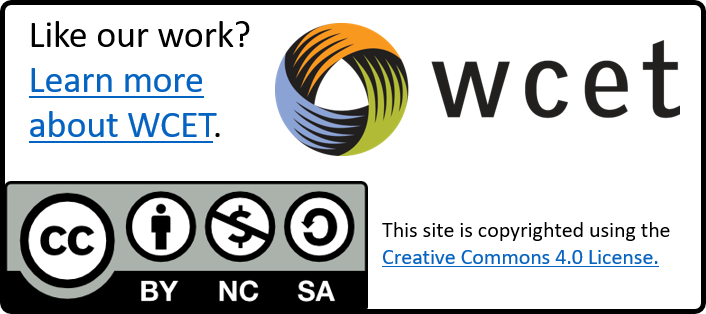We’ve written several posts on the negotiated rulemaking process and updates to state authorization and accreditation regulations. Today we hear from another participant in the innovation negotiated rulemaking process on that experience and her institution’s take on new models of learning. We’re excited to welcome Jillian Klein from Strategic Education, Inc. to discuss Capella University’s CBE and direct assessment learning models and their experiences with implementing these programs for their students. Jillian offers five excellent lessons learned from their journey on the CBE path.
Thank you to Jillian for today’s great post!
Enjoy the read and enjoy your day,
Lindsey Downs, WCET
Earlier this year, I spent the better part of four months in windowless rooms in Washington, D.C., participating in the Department of Education’s Accreditation and Innovation negotiated rulemaking process. Despite the unglamorous setting, our committee had an unbelievably important task ahead of us: negotiating recommended rule changes for a whole host of issues related to distance education and innovation. We were especially focused on how higher education funding rules needed to evolve to accommodate the growing prevalence of online education—and the new modes of learning, such as competency-based education (CBE), that it enables—while still protecting students and taxpayers.
Challenge Accepted: Negotiating Rulemaking
Consider the challenge we have at our institutions in getting even five colleagues around a table to agree on a decision. Now, magnify that a hundredfold when you have 20 smart, passionate, diverse, thoughtful higher education thinkers charged with the task of agreeing on regulatory language about issues as complex as state authorization for online students, or on the definition of an “instructor!”
Folks familiar with negotiated rulemaking say that reaching consensus—the end goal—means that no one gets everything they want, but that everyone around the table can at least live with the final language.

Our committee certainly had its share of compromising to do. Some changes were met with overwhelming support, while others—like repealing the credit hour in the absence of a tested alternative—were met with almost unanimous pushback. Ultimately, we had a big stage to highlight the ways in which innovative learning models, such as CBE, are transforming the student experience—and to show ways in which the current federal framework needs to evolve.
The Particular Challenge of CBE
The complexity of federal regulations around CBE—especially direct assessment—is, no doubt, a major reason why more colleges and universities haven’t rolled out more programs using that approach. In a recent national survey by the American Institutes for Research, 86% of institutions said they were interested in or in the process of adopting CBE—yet only 11% of those surveyed actually met the threshold for offering such programs. That is consistent with other national estimates, which suggest only about 600 colleges and universities offer some form of CBE. And only a handful of institutions—such as Capella University, Southern New Hampshire University (SNHU), and the University of Wisconsin-Extension—have gone through the federal approval process to offer direct assessment programs.
But while the process for offering direct assessment programs, or any form of CBE, remains complicated, it is far from impossible. My colleagues and I have learned a number of lessons from Capella’s five years of offering direct assessment bachelor’s and master’s degree programs—and we hope they can help guide other institutions interested in launching competency-based programs.
Lessons Learned from Direct Assessment Programs
1. Direct assessment delivers on its promise to save students both time and money. The direct assessment model allows students to fit education into their lives, at the intensity level and at times that work for them. They are able to move faster when they can, and to slow down with concepts that take more time for them to master. This approach can allow students to progress more quickly. Students in direct assessment programs are often charged less and borrow less than their counterparts in equivalent programs tied to the credit hour. These cost savings demonstrate the power of the mastery model of education to create more affordable pathways for students, particularly working adults.
2. Students value flexibility. When Capella started designing our direct assessment programs, it settled on a 12-week subscription pricing model that allows students to take an “all you can learn” approach to their studies. We thought students would be drawn to the programs because they wanted to earn a degree more quickly and pay less in the process. While that’s certainly proved true for some students, others simply value the flexibility afforded by the direct assessment approach. As adult students, their work and family commitments are such that a traditional education, even online, isn’t a viable option for them. As other institutions explore competency-based education, this is a useful reminder that flexibility for the learner is key. Any new models should allow students to fit education around their lives, not the other way around.
3. The importance of investing in tools to support students cannot be overstated. New models, either direct assessment or CBE that is still tied to the credit hour, can create better educational pathways for students. But they still need help navigating these programs. In fact, students may need extra support in understanding approaches to education that are less familiar. It’s especially important to have a robust orientation for students in direct assessment programs, because they don’t look exactly like a credit-hour programs with which students are more familiar. Consistent, on-going communication and dedicated coaching are critical for student success. For us, the coach is a dedicated support position that helps learners overcome obstacles they encounter in their educational journey—such as time management, resources, and even personal matters.
4. Faculty—no matter how their role changes—remain integral to student success. We have experimented with both a traditional faculty role and an unbundled model for delivering direct assessment programs. Institutions often assume that the unbundled faculty model—where the workload is shared among subject matter experts, rather than being assumed by a single faculty member—is a necessary element of a CBE program. We’ve seen pros and cons to both models. But what is abundantly clear is the importance, in general, of the role of the faculty within these innovative learning programs. From course and program design, to tutoring and one-on-one instruction, to evaluation and feedback, the role of the faculty is integral to the success of students in competency-based education programs. And as the faculty role continues to evolve across higher education, it is critical that we ensure faculty are at the table as we discuss how their role can evolve to meet the needs and expectations of today’s students.
5. The existing federal financial aid construct needs to evolve. We can say one thing above all else: the existing federal financial aid system—based on credit hours and assuming traditional enrollment patterns—is not optimal for evolving learning models. Mapping our direct assessment programs onto existing, largely antiquated rules for federal financial aid presented a significant challenge—and it remains an awkward fit today.  Across the field of higher education, the sheer magnitude of that process has reduced the number and type of institutions with the capacity to offer direct assessment programs. It also creates confusion for students and makes it hard for them to know when they’ll be receiving aid.
Across the field of higher education, the sheer magnitude of that process has reduced the number and type of institutions with the capacity to offer direct assessment programs. It also creates confusion for students and makes it hard for them to know when they’ll be receiving aid.
The good news is that the U.S. Department of Education—on the recommendation of the recent negotiated rule-making panel—is currently considering a new aid framework that bases student eligibility on a form of academic progression that more accurately reflects the educational course of part-time students. The Department also is considering the panel’s recommendation to allow for hybrid models that would enable students to combine direct assessment programs with some more traditional coursetaking. Both changes would greatly expand the pool of students—and the number of institutions—for whom direct assessment models would make sense.
6. Don’t be afraid to experiment. As Charla Long, Executive Director of the Competency-Based Education Network, has written: too many institutions are held back by uncertainty. I hope these lessons learned are helpful to other institutions and I encourage other institutions to continue to share lessons learned from their experiences with offering CBE so that others will experiment with new models for this approach to education.

Three quarters of today’s students are working, supporting children, or are otherwise “nontraditional,” and the status quo isn’t meeting their needs. They need a new kind of higher education, and it’s up to us to build it.

Jillian Klein
SVP, Government & Regulatory Affairs
Strategic Education, Inc.


 Across the field of higher education, the sheer magnitude of that process has reduced the number and type of institutions with the capacity to offer direct assessment programs. It also creates confusion for students and makes it hard for them to know when they’ll be receiving aid.
Across the field of higher education, the sheer magnitude of that process has reduced the number and type of institutions with the capacity to offer direct assessment programs. It also creates confusion for students and makes it hard for them to know when they’ll be receiving aid.


1 reply on “It’s Up to Us to Build It: Lessons Learned from Five Years in the Vanguard of CBE”
[…] Competency based education and direct assessment. The proposed regulations seek to support the continued development of these innovative educational methods by defining criteria for these programs to participate in Title IV aid. […]